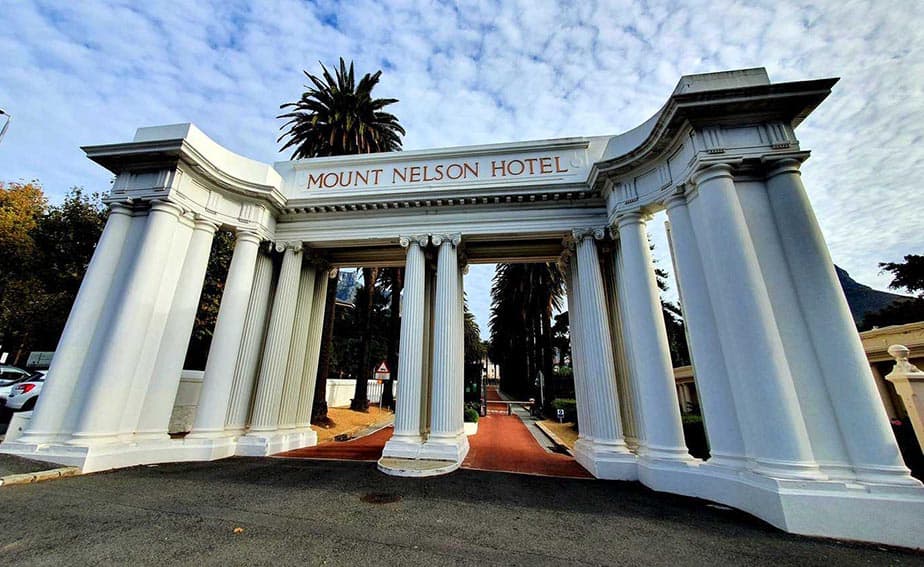Представьте себе эту сцену: 24 гигантские белые колонны поддерживают фронтон, объявляющий себя «отелем Mount Nelson Hotel» – это, пожалуй, самый грандиозный вход, который вы когда-либо видели.
Этот вход указывает путь к знаменитому пятизвездочному отелю в Кейптауне.
Проезжая через Ворота Принца Уэльского и поднимаясь по пальмовой дорожке, вы почувствуете, что здесь более 270 лет звёздной истории.
Очарование Старого Света
Когда вы подходите к входному портику, шум городского транспорта затихает, сменяясь очарованием Старого Света, словно разворачивающаяся африканская колониальная басня, эпоха великих океанских лайнеров и послеобеденный чай, подаваемый официантами в белых перчатках.
Отель одновременно гламурный, традиционный и романтичный. Стены украшены натянутыми холстами, венецианскими зеркалами, а мебель обтянута роскошными тканями.
Это тихий уголок исторической элегантности. Одна из самых почитаемых достопримечательностей Кейптауна, известная своим бледно-розовым фасадом, ухоженными садами и, не в последнюю очередь, своим послеобеденным чаем.
Оживление легендарного прошлого
Первые 147 лет отель был частным поместьем, а в 1890 году территорию и здания приобрел судоходный магнат сэр Дональд Карри, владелец судоходной компании Union Castle.
Его мечтой было построить отель, такой же стильный и элегантный, как лондонские, предназначенный исключительно для состоятельных пассажиров первого класса пароходной линии Castle Line.
Mount Nelson открыт в 1899 году
Год спустя, в мае 1899 года, Mount Nelson распахнул свои двери. Это был первый отель в Южной Африке, предлагавший горячую и холодную воду, и он быстро стал лидером индустрии гостеприимства страны.
Примерно в то же время в Южной Африке были обнаружены месторождения золота и алмазов, что сделало Кейптаун привлекательным местом, предлагающим уникальные бизнес-возможности для тех, кто готов ими воспользоваться.
В том же году началась англо-бурская война. Британцы использовали отель в качестве штаб-квартиры для планирования своей военной кампании.
Лорды Робертс, Китченер и Буллер были привычными фигурами в коридорах отеля.
Молодой военный корреспондент Уинстон Черчилль, работавший в этом отеле, описывал его так: «…превосходнейшее и прекрасно оборудованное заведение, которое можно по достоинству оценить после морского путешествия».
Узнав об истории отеля, отрезвляет мысль о том, что будущее Южной Африки формировалось в той самой комнате, где я пил послеобеденный чай.
Столь откровенный, откровенный драматизм требует внимания.
А название? Название «Гора» было вдохновлено Столовыми горами Кейптауна, расположенными прямо за ним, и лордом Горацио Нельсоном, дважды посетившим Кейптаун.
Где всё есть
Чай пьют в зимнем саду на открытом воздухе, в саду или в чайной гостиной – уютном месте, отражающем фирменный колониальный стиль отеля, с коврами и обивкой Aubusson (нежно-розовых оттенков), которое ведет на большую садовую веранду отеля.
Расположившись в великолепном лаунже отеля Belmond Mount Nelson, я наслаждаюсь послеобеденным чаепитием из трёх блюд, которое подают волнами гастрономического совершенства.
Заказав чай, я откидываюсь на спинку кресла с высокой спинкой, наслаждаясь спокойствием и умиротворением.
Пианист за кабинетным роялем играл несколько классических произведений, которые, по какой-то причине, навеяли мне воспоминания о моём отце, который, вспоминая своё пребывание в Индии, научил меня, почему важно пить чай из блюдца.
Постоянно меняющееся меню начинается с несладких блюд: мини-сэндвичей с нежной сливочной начинкой, жареной курицы, завернутой в рисовую бумагу, сырных крокетов.
В меню есть киши, бобо, эмпанадас с грибами, фриккадель и пакоры из цветной капусты с луком.
Именно здесь началась моя любовь к сконам.
За этим следует основное блюдо: куксистеры, посыпанные кокосом, тыквенные оладьи, влажный лимонный сок. На десерт – булочка с маком, корзинка свежеиспечённых тёплых булочек, поданных с сыром, взбитыми сливками, кремом шантильи и миской клубничного джема.
В заключение – десерт: молочный тарт с корицей и кардамоном, шоколадные эклеры, запечённый чизкейк с белым шоколадом, ягодные тарталетки, деликатесы, шоколадные брауни и морковный торт.
Крейг Купидо – первый чайный сомелье Южной Африки – знакомит меня со своим 6‑страничным меню сочетаний чая и объясняет, почему определённые чаи сочетаются с определёнными блюдами.
Я выбрал землистый, но в то же время нежный ройбуш с апельсином и пряностями из Седерберга – прекрасное дополнение.
Смущённые истории
После нашей беседы о чаепитиях Крейг прибавил громкости: «Вот вам забавная история», – говорит Крейг.
«Говорят, что напольные часы в гостиной, датируемые началом XIX века, пробили полночь так громко, что их было слышно в гавани Кейптауна – за несколько миль.
Однажды ночью разгневанный гость забил в куранты два шестидюймовых гвоздя, и 20 лет они молчали, пока один из гостей не предложил их починить. Они всё ещё бьют полночь, но уже не так громко».
Воодушевляясь, Крейг рассказывает мне больше. В своё время итальянский управляющий отеля Альдо Ренато отпраздновал окончание Первой мировой войны, покрасив здание в розовый цвет, что вызвало бурную реакцию по всей Европе в последующие десятилетия.
Отель Belmond Mount Nelson и по сей день остаётся розовым. Более того, эксперты по краскам разработали тот самый неповторимый оттенок «Mount Nelson Pink».
Знаменитости
Я спросил о знаменитостях, которые останавливались в этом отеле. «Сэр Артур Конан Дойл был одним из них, — продолжает Крейг, — как и Джон Леннон, медитировавший в саду под этим деревом.
А ещё был Далай-лама, который просветлял местных жителей и сидел, скрестив ноги, на полу бального зала.
Сэр Элтон Джон регулярно навещает нас, как и члены британской королевской семьи — королева Елизавета II отметила с нами свой 21‑й день рождения.
Президент Нельсон Мандела провёл здесь первый в мире Всемирный экономический форум на африканской земле. Кинозвёзды, рок-звёзды, супермодели, — он махнул рукой в сторону Столовой горы, — их слишком много, чтобы перечислить».
Когда-то послеобеденный чай, возможно, был простым занятием, имевшим практическую цель, но в «Розовой леди», как любовно называют гору Нельсон, это просто и, без сомнения, настоящее чувственное наслаждение, которое нельзя пропустить.

